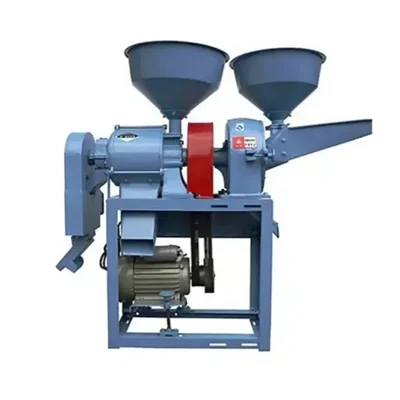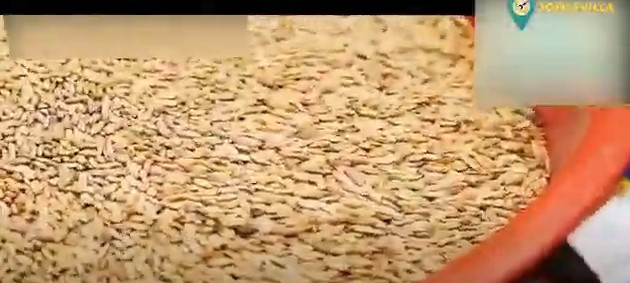- Farm & Garden
- Pumps & Motors
- Food Processing
- Workshop, DIY & MRO
- Lab & Measuring Tools

Brand: Generic (Imported)
3 in 1 Multipurpose Rice Milling Machine Without Motor (Required 3HP motor)
SKU: PD-AE-20222484
 3926 people have viewed this recently
3926 people have viewed this recently  Delivery By: Dec 21 - Dec 23
Delivery By: Dec 21 - Dec 23 




MRP : ₹27000 ₹26000
4% OFF!

 3926 people have viewed this recently
3926 people have viewed this recently  Delivery By: Dec 21 - Dec 23
Delivery By: Dec 21 - Dec 23 
Easy Return
& Refund
& Refund

Quality
Assurance
Assurance

Trusted
Delivery
Delivery

After Sales
Assistance
Assistance

Buyer
Protection
Protection
₹26000 (Including GST)
MRP : ₹27000
4% OFF!
Get Extra ₹390 OFF on Prepaid Orders
QTY :
-
1
+
Short Description
Multipurpose 3 in 1 Rice Milling Machine
Required Motor 3HP
Body Material Mild Steel
Country of origin: China
Specifications
- Brand: Generic (Imported)
- Material : Mild Steel
- Weight (Approx.) : 100 kg
- Model No. : 6N100 with 9FC Grinder
- Product Type : 3 in1 Milling Machine
- Brand : Generic (Imported)
- Required Motor : 3HP
- Phase : Single
- Capacity of Rice : 200-250 Kg/hr
- Capacity of Flour : 40-80 Kg/hr
- Body Material : Mild Steel
- Power Consumption : 2.5 unit/hr
Note :
- The color of the product may vary.
- The images are for reference only, the motor is not included with the machine.
Description
3 in 1 Multipurpose Rice mill is a machine which is manufactured by combining the functionality of three different machines into one. By integrating the functionality of multiple units into one, this rice mill offers increased efficiency, reduced labor requirements and improved overall productivity. This type of rice mill is ideal for small to medium scale rice processing facilities or individual farmers who are looking for a better option to streamline the rice processing process. This machine requires a 3 HP single phase motor with to achieve the processing capacity of 200-250 kilograms per hour and that of flour is 40-80 kilograms per hour.
Features
:- Dual Functionality : The most significant feature of this machine is its ability to perform two operations; milling and pulverizing in one unit. This dual functionality saves space, reduces the need for multiple machines, and enhances operational efficiency.
- High Efficiency : Combined rice mills and pulverizers are designed to operate at high speeds, allowing them to process large quantities of rice and grains in a relatively short time. This efficiency is crucial for commercial operations where time and productivity are essential.
- Cost-Effectiveness : The combined rice mill and pulverizer is more affordable than larger commercial units, making them accessible for small-scale farmers or entrepreneurs looking to enter the rice milling business without significant capital investment.
- Durability and Maintenance : The combined rice mill and pulverizer is made from durable materials that can withstand regular use. Additionally, it requires minimal maintenance, making them cost-effective over time.
Applications
:Rice Processing (Milling & Polishing):
- Paddy to White Rice: The most significant application is efficiently converting raw paddy (unhusked rice) into polished white rice.
De-husking & Whitening: The machine simultaneously removes the outer husk and the bran layer, giving a finished product ready for consumption.
By-Product Collection: It separates the by-products (husk and bran), which can be used as animal feed or fertilizer.
2. Grain Milling and Pulverizing (Flour/Meal Production): The pulverizer/grinder component allows the machine to process various dry materials into powder or flour. This is ideal for small-scale flour production.
3. Cleaning and Refining:Destoning: Many 3-in-1 models include a destoner function that uses vibration to effectively separate heavy impurities like small stones and metallic particles from the paddy or grain before milling/grinding. This protects the machine and improves food safety.
Refining/Multiple Grinding: Other models may offer a refining function or a multi-functional grinding unit designed for finer grinding or even processing wet materials (like soaked dal/lentils for batter).
Usage
:- Rice Milling (Paddy to White Rice): This is the primary function, used to process raw paddy (unhusked rice) into edible white rice.
- De-husking/Shelling: Removes the outer husk from the paddy grain.
- Whitening/Polishing: Removes the rice bran layer from the brown rice, resulting in polished white rice.
- Separation: Efficiently separates the finished white rice from the by-products (husk and bran).
2. Pulverizing/Grinding (Dry Materials):
The machine includes a built-in pulverizer (often a disc mill or hammer mill) for grinding dry materials into fine powder or flour.
- Grain Milling: Grinding various cereal grains into flour (Atta) for domestic or commercial use:
3. Destoning or Multi-functional Grinding:
The third function can vary by model, but it is typically one of the following:
- Destoning (Most Common for "3 in 1"): This chamber/mechanism removes small stones and heavy impurities from the grains. Before milling or grinding, which is crucial for producing high-quality food products and protecting the main milling components from damage.
Maintenance:
I. Cleaning and Inspection :-
2. This is the most critical step to prevent blockages, contamination, and premature wear.
- Chamber Cleaning: Thoroughly clean the milling chamber and pulverizer chamber to remove all leftover rice, bran, husk, dust, or flour.
4. Sieves and Screens: Inspect and clean the screens, sieves, and jalis immediately. Clogged screens reduce efficiency and pressure, affecting output quality and causing overheating. Replace the screen promptly if it is damaged or has worn-out mesh holes. Hopper and Discharge Outlets: Clear the feeding hopper and all discharge points to ensure a smooth flow during the next operation.
5. Exterior: Wipe down the machine's exterior to remove dust, bran, and spilled materials.
II. Mechanical Component :-
Maintenance Focus on the components that perform the milling and grinding work, as they experience the most wear.
6. Component Maintenance Action Inspection Focus Rubber Rollers Check the condition of the rubber on the rollers. If the rubber is significantly worn, replace both the fast and slow rollers simultaneously to maintain balance and proper hulling rate. Milling/Whitening Components Inspect the rice knives/blades and polishing cylinder/stone.
- Rice Knives: If blunt, they can often be reversed or turned around for continued use, but must be replaced if severely damaged.
- Pulverizer Blades Check the blades for sharpness and tightness.
- Dull Blades: Sharpen or replace dull blades to maintain grinding efficiency and prevent excessive noise/vibration.
- Bearings and Shafts Lubrication: Regularly add or replace grease/lubricating oil in all bearing points, following the manufacturer's recommendations.
- Overheating: Check for signs of localized heat, which indicates friction and inadequate lubrication.
- Belts and Pulleys : Since the motor is separate, inspect the pulleys and drive belts that will be used.
- Tension: Check belt tension; it should be neither too tight (stress on bearings) nor too loose (slippage, reduced power).
- Wear: Replace belts immediately if they show signs of cracking, fraying, or excessive stretching.
Maintaining the integrity and precision of the machine prevents excessive vibration and poor output quality.
7. Tightening: Routinely check and tighten all bolts, nuts, and fasteners on the frame, chambers, and mounting points.
8. Loose hardware is the primary cause of high vibration and wear. Alignment: Ensure that all critical components, such as the milling rollers and shafts, are properly aligned and calibrated.
9. Misalignment leads to uneven milling, excessive grain breakage, and rapid part wear.
10. Storage: If the machine is to be stored for a long period: Clean it thoroughly. Ensure all metal parts are coated with a light film of oil or rust-preventive spray.
11. Loosen the drive belts to prevent them from stretching or being stressed.12Cover the machine to protect it from dust and moisture.
IV. Operational Best Practices:-
Paddy Quality: Only feed clean and dry paddy into the machine.
13. Foreign objects (stones, metal, nails) or wet paddy can cause immediate damage, clogging, and component wear.
14. Uniform Feed: Maintain a steady, uniform feed rate. Overloading the chambers places undue strain on all mechanical parts, the drive system, and the external motor.
15. Use Genuine Parts: When replacement is necessary, always use genuine parts or those recommended by the manufacturer to ensure compatibility and performance.

Select attribute










